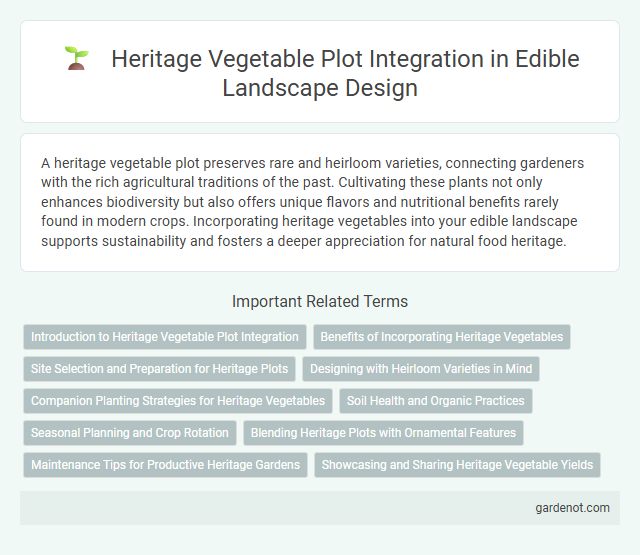A heritage vegetable plot preserves rare and heirloom varieties, connecting gardeners with the rich agricultural traditions of the past. Cultivating these plants not only enhances biodiversity but also offers unique flavors and nutritional benefits rarely found in modern crops. Incorporating heritage vegetables into your edible landscape supports sustainability and fosters a deeper appreciation for natural food heritage.
Introduction to Heritage Vegetable Plot Integration
Heritage vegetable plots preserve heirloom varieties that offer unique flavors, genetic diversity, and cultural significance within edible landscapes. Integrating these plots supports biodiversity, promotes sustainable gardening, and connects gardeners with historical agriculture. Incorporating heritage vegetables enhances soil health and provides a resilient food source adapted to local conditions.
Benefits of Incorporating Heritage Vegetables
Incorporating heritage vegetables into an edible landscape enhances biodiversity by preserving rare and heirloom varieties, promoting genetic diversity crucial for resilient ecosystems. These vegetables offer superior nutritional profiles and unique flavors, enriching culinary experiences while supporting sustainable agricultural practices. Cultivating heritage varieties fosters cultural heritage and educates communities about traditional farming methods, strengthening the connection between food and history.
Site Selection and Preparation for Heritage Plots
Choosing a well-drained, sunny site with fertile soil is crucial for a successful heritage vegetable plot, as these plants thrive in environments that replicate their original growing conditions. Soil preparation involves deep digging and incorporation of organic matter such as compost or well-rotted manure to improve soil structure and nutrient content. Testing soil pH and adjusting it to the optimal range of 6.0 to 7.0 ensures maximum nutrient availability for heritage varieties, which often require specific conditions to produce flavorful and robust crops.
Designing with Heirloom Varieties in Mind
Designing an edible landscape with heirloom varieties in mind emphasizes preserving genetic diversity and cultural heritage through cultivating unique, flavor-rich vegetables such as 'Brandywine' tomatoes, 'Golden Bantam' corn, and 'Cosse Violette' beans. Incorporating heirloom seeds in heritage vegetable plots enhances soil health by promoting biodiversity and encourages sustainable gardening practices tailored to local climates. Strategic placement and companion planting of heirloom crops ensure robust growth, pest resistance, and visually appealing garden layouts that celebrate historical agriculture.
Companion Planting Strategies for Heritage Vegetables
Companion planting strategies for heritage vegetables enhance growth and pest resistance by pairing compatible species, such as planting beans alongside corn to fix nitrogen in the soil. Marigolds are commonly used to deter nematodes and aphids, promoting healthier heritage tomato and cabbage plants. Integrating herbs like basil or thyme near heritage vegetables also boosts flavor while supporting beneficial insect populations.
Soil Health and Organic Practices
Heritage vegetable plots prioritize soil health through organic practices that enhance microbial diversity and nutrient cycling, ensuring sustainable fertility. Incorporating compost, cover crops, and crop rotation minimizes chemical inputs while improving soil structure and moisture retention. These practices promote resilient plant growth and preserve heirloom varieties within an edible landscape.
Seasonal Planning and Crop Rotation
Seasonal planning in a heritage vegetable plot involves selecting crops that thrive in specific seasons to maximize yield and maintain soil health. Crop rotation prevents the depletion of soil nutrients and reduces pest and disease buildup by alternating plant families such as legumes, brassicas, and root vegetables. Implementing these practices enhances biodiversity and sustains the long-term productivity of the edible landscape.
Blending Heritage Plots with Ornamental Features
Blending heritage vegetable plots with ornamental features creates a visually appealing and productive edible landscape that honors biodiversity and cultural history. Incorporating heirloom varieties like 'Black Krim' tomatoes and 'Cinderella' pumpkins alongside ornamental flowers such as nasturtiums and marigolds enhances pest control and attracts beneficial pollinators. This integration promotes sustainability by preserving genetic diversity while enriching the garden's aesthetic value.
Maintenance Tips for Productive Heritage Gardens
Maintaining productive heritage vegetable gardens requires consistent soil enrichment with organic compost to support nutrient-rich growth. Regular crop rotation and companion planting help prevent pest infestations and soil depletion, ensuring sustainable harvests. Adequate mulching conserves moisture and suppresses weeds, promoting healthier plants in edible landscapes.
Showcasing and Sharing Heritage Vegetable Yields
Heritage vegetable plots cultivate traditional, heirloom varieties that preserve biodiversity and cultural history. Showcasing these unique yields highlights their distinct flavors, colors, and nutritional benefits, encouraging community engagement and sustainable gardening practices. Sharing harvests from heritage plots fosters knowledge exchange, promotes seed saving, and supports local food security initiatives.
Heritage vegetable plot Infographic

 gardenot.com
gardenot.com